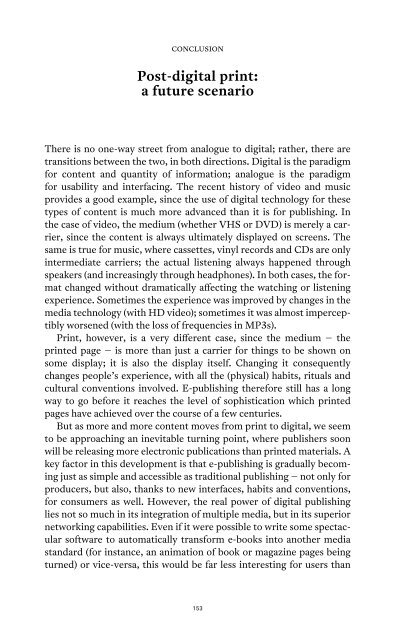Post- Digital Print - Monoskop
Post- Digital Print - Monoskop
Post- Digital Print - Monoskop
Create successful ePaper yourself
Turn your PDF publications into a flip-book with our unique Google optimized e-Paper software.
conclusion<br />
<strong>Post</strong>-digital print:<br />
a future scenario<br />
There is no one-way street from analogue to digital; rather, there are<br />
transitions between the two, in both directions. <strong>Digital</strong> is the paradigm<br />
for content and quantity of information; analogue is the paradigm<br />
for usability and interfacing. The recent history of video and music<br />
provides a good example, since the use of digital technology for these<br />
types of content is much more advanced than it is for publishing. In<br />
the case of video, the medium (whether VHS or DVD) is merely a carrier,<br />
since the content is always ultimately displayed on screens. The<br />
same is true for music, where cassettes, vinyl records and CDs are only<br />
intermediate carriers; the actual listening always happened through<br />
speakers (and increasingly through headphones). In both cases, the format<br />
changed without dramatically affecting the watching or listening<br />
experience. Sometimes the experience was improved by changes in the<br />
media technology (with HD video); sometimes it was almost imperceptibly<br />
worsened (with the loss of frequencies in MP3s).<br />
<strong>Print</strong>, however, is a very different case, since the medium – the<br />
printed page – is more than just a carrier for things to be shown on<br />
some display; it is also the display itself. Changing it consequently<br />
changes people’s experience, with all the (physical) habits, rituals and<br />
cultural conventions involved. E-publishing therefore still has a long<br />
way to go before it reaches the level of sophistication which printed<br />
pages have achieved over the course of a few centuries.<br />
But as more and more content moves from print to digital, we seem<br />
to be approaching an inevitable turning point, where publishers soon<br />
will be releasing more electronic publications than printed materials. A<br />
key factor in this development is that e-publishing is gradually becoming<br />
just as simple and accessible as traditional publishing – not only for<br />
producers, but also, thanks to new interfaces, habits and conventions,<br />
for consumers as well. However, the real power of digital publishing<br />
lies not so much in its integration of multiple media, but in its superior<br />
networking capabilities. Even if it were possible to write some spectacular<br />
software to automatically transform e-books into another media<br />
standard (for instance, an animation of book or magazine pages being<br />
turned) or vice-versa, this would be far less interesting for users than<br />
153

















